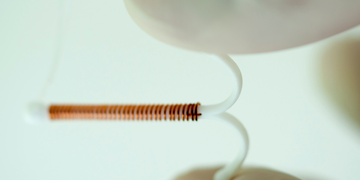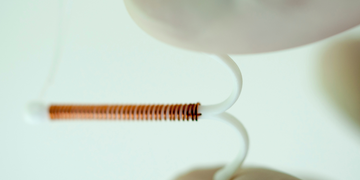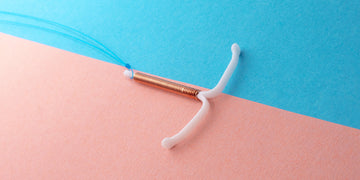How does the copper IUD work as an emergency contraceptive?

Did you know that the non-hormonal IUD can be used as emergency contraception after unprotected sex? Many are surprised when they learn that emergency contraception is not just the morning-after pill. In this article, we’ll review how the copper IUD works, its efficacy rates, and how to get it inserted.
What is the copper IUD?
The copper IUD (intrauterine device) is a small, t-shaped device that’s either made of copper or plastic wrapped in copper. You can use the copper IUD (also known as ParaGard) as both emergency contraception and your regular method of birth control once inserted.
How does the copper IUD work?
After being inserted into your uterus, the copper IUD prevents pregnancy by creating a hostile environment for sperm to prevent them from reaching your eggs. The device doesn’t use hormones to prevent pregnancy, and it won’t terminate an existing pregnancy.
When can you use the copper IUD? How effective is it?
You can use the copper IUD as an emergency contraceptive or as long-term, reversible birth control. If you choose to use it to prevent pregnancy after unprotected sex, it has to be inserted by a doctor within 5 days. IUDs have some of the best efficacy rates of all contraceptive options; they work more than 99% of the time.
What to know about the copper IUD as an emergency contraceptive
If you’re considering the copper IUD as an emergency contraceptive, you will have to have it inserted within 5 days of having unprotected sex. Keeping it in as your long-term birth control could be more cost-effective than removing it after using it as an emergency contraceptive. An IUD prevents pregnancy as long as it’s in place, but it can’t protect you from sexually transmitted infections.
Is the copper IUD safe?
You might experience side effects such as severe menstrual pain, heavy bleeding, and bleeding between periods. The copper IUD doesn’t have a high risk for dangerous side effects. However, your primary care provider might not recommend it if:
- You’re allergic to any of its components
- You have a disorder that may lead to copper accumulation in vital organs (Wilson’s disease)
- Uterine fibroids or other vaginal abnormalities might keep the IUD from being placed or kept in the right spot
- An abnormally-shaped uterus
- You have uterine or cervical cancer
- You have a pelvic infection
- You’re currently experiencing unexplained or undiagnosed vaginal bleeding
The risk of the IUD expelling from the uterus may be higher for some. There are factors to take into consideration when deciding if a copper IUD is right for you. Some things to consider are:
- If you experience heavy or long-lasting periods
- If you experience severe menstrual pain
- If you have expelled an IUD before
- You’re trying to insert an IUD immediately following childbirth
Contact your primary healthcare provider immediately following IUD insertion if you:
- Might have been exposed to a sexually transmitted infection
- Are experiencing signs or symptoms of pregnancy
- Experience abnormal bleeding, pain, or vaginal discharge
- Have an unexplained or undiagnosed fever
- Think the IUD has moved out of place
It may be hard to tell if the IUD has shifted or gets expelled. Some signs that it may have moved include:
- Sex is painful for you or your partner
- Breakthrough bleeding occurs during or after sex
- You can feel part of the device in your vagina or at your cervix
- IUD strings feel longer or are missing
How long does the copper IUD last?
Unlike other emergency contraceptives, the copper IUD can also be long-term birth control. The device can last up to 10-12 years, and you can remove it at any time within this period. There might be some light bleeding and cramping during the placement and removal of the IUD, and following the procedure. If you’re looking to conceive but have the copper IUD, you can start trying to get pregnant as soon as you have the device removed.
Where can you get the copper IUD?
To get a copper IUD, you will need to visit your OBGYN to have it ordered for you and then placed. A doctor will insert it through your vagina and into your uterus. Your healthcare provider may follow up about a month after the procedure to check for infection and make sure the device is in the correct location.
What are the benefits of the copper IUD?
Benefits of choosing the copper IUD include:
- The rates of efficacy (over 99%)
- Ability to be used both as an emergency contraceptive and as long-term birth control
- If you do decide you want to get pregnant, you can start trying immediately upon removal
Like anything, using the copper IUD isn’t a perfect solution. Possible drawbacks are:
- The need for a prescription and office visit to have the IUD placed — other emergency contraceptive methods (like the morning-after pill) are available online or over-the-counter at most drugstores
- Insertion may be painful or uncomfortable, especially if you’ve never given birth
- Changes to your menstrual cycle — your primary care provider might not recommend using a copper IUD because the IUD can make heavy and painful periods even worse
- Lack of protection from sexually transmitted infections
If you’re considering the copper IUD, whether for use as an emergency contraceptive or as long-term birth control, we encourage you to speak with your primary care provider to help you determine whether it's right for you.
For more articles on everything related to reproductive health, check out our education hub, Real Talk.
Keep Reading

How to prevent pregnancy after unprotected sex or birth control failure
Apr 27

3 things to know when choosing an IUD
Feb 9

Can you get pregnant with an IUD?
Dec 3








